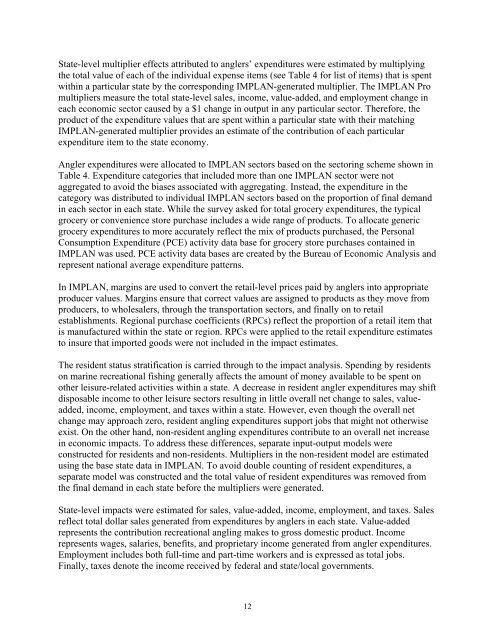The Economic Contribution of Marine Angler Expenditures in the ...
The Economic Contribution of Marine Angler Expenditures in the ...
The Economic Contribution of Marine Angler Expenditures in the ...
You also want an ePaper? Increase the reach of your titles
YUMPU automatically turns print PDFs into web optimized ePapers that Google loves.
State-level multiplier effects attributed to anglers’ expenditures were estimated by multiply<strong>in</strong>g<br />
<strong>the</strong> total value <strong>of</strong> each <strong>of</strong> <strong>the</strong> <strong>in</strong>dividual expense items (see Table 4 for list <strong>of</strong> items) that is spent<br />
with<strong>in</strong> a particular state by <strong>the</strong> correspond<strong>in</strong>g IMPLAN-generated multiplier. <strong>The</strong> IMPLAN Pro<br />
multipliers measure <strong>the</strong> total state-level sales, <strong>in</strong>come, value-added, and employment change <strong>in</strong><br />
each economic sector caused by a $1 change <strong>in</strong> output <strong>in</strong> any particular sector. <strong>The</strong>refore, <strong>the</strong><br />
product <strong>of</strong> <strong>the</strong> expenditure values that are spent with<strong>in</strong> a particular state with <strong>the</strong>ir match<strong>in</strong>g<br />
IMPLAN-generated multiplier provides an estimate <strong>of</strong> <strong>the</strong> contribution <strong>of</strong> each particular<br />
expenditure item to <strong>the</strong> state economy.<br />
<strong>Angler</strong> expenditures were allocated to IMPLAN sectors based on <strong>the</strong> sector<strong>in</strong>g scheme shown <strong>in</strong><br />
Table 4. Expenditure categories that <strong>in</strong>cluded more than one IMPLAN sector were not<br />
aggregated to avoid <strong>the</strong> biases associated with aggregat<strong>in</strong>g. Instead, <strong>the</strong> expenditure <strong>in</strong> <strong>the</strong><br />
category was distributed to <strong>in</strong>dividual IMPLAN sectors based on <strong>the</strong> proportion <strong>of</strong> f<strong>in</strong>al demand<br />
<strong>in</strong> each sector <strong>in</strong> each state. While <strong>the</strong> survey asked for total grocery expenditures, <strong>the</strong> typical<br />
grocery or convenience store purchase <strong>in</strong>cludes a wide range <strong>of</strong> products. To allocate generic<br />
grocery expenditures to more accurately reflect <strong>the</strong> mix <strong>of</strong> products purchased, <strong>the</strong> Personal<br />
Consumption Expenditure (PCE) activity data base for grocery store purchases conta<strong>in</strong>ed <strong>in</strong><br />
IMPLAN was used. PCE activity data bases are created by <strong>the</strong> Bureau <strong>of</strong> <strong>Economic</strong> Analysis and<br />
represent national average expenditure patterns.<br />
In IMPLAN, marg<strong>in</strong>s are used to convert <strong>the</strong> retail-level prices paid by anglers <strong>in</strong>to appropriate<br />
producer values. Marg<strong>in</strong>s ensure that correct values are assigned to products as <strong>the</strong>y move from<br />
producers, to wholesalers, through <strong>the</strong> transportation sectors, and f<strong>in</strong>ally on to retail<br />
establishments. Regional purchase coefficients (RPCs) reflect <strong>the</strong> proportion <strong>of</strong> a retail item that<br />
is manufactured with<strong>in</strong> <strong>the</strong> state or region. RPCs were applied to <strong>the</strong> retail expenditure estimates<br />
to <strong>in</strong>sure that imported goods were not <strong>in</strong>cluded <strong>in</strong> <strong>the</strong> impact estimates.<br />
<strong>The</strong> resident status stratification is carried through to <strong>the</strong> impact analysis. Spend<strong>in</strong>g by residents<br />
on mar<strong>in</strong>e recreational fish<strong>in</strong>g generally affects <strong>the</strong> amount <strong>of</strong> money available to be spent on<br />
o<strong>the</strong>r leisure-related activities with<strong>in</strong> a state. A decrease <strong>in</strong> resident angler expenditures may shift<br />
disposable <strong>in</strong>come to o<strong>the</strong>r leisure sectors result<strong>in</strong>g <strong>in</strong> little overall net change to sales, valueadded,<br />
<strong>in</strong>come, employment, and taxes with<strong>in</strong> a state. However, even though <strong>the</strong> overall net<br />
change may approach zero, resident angl<strong>in</strong>g expenditures support jobs that might not o<strong>the</strong>rwise<br />
exist. On <strong>the</strong> o<strong>the</strong>r hand, non-resident angl<strong>in</strong>g expenditures contribute to an overall net <strong>in</strong>crease<br />
<strong>in</strong> economic impacts. To address <strong>the</strong>se differences, separate <strong>in</strong>put-output models were<br />
constructed for residents and non-residents. Multipliers <strong>in</strong> <strong>the</strong> non-resident model are estimated<br />
us<strong>in</strong>g <strong>the</strong> base state data <strong>in</strong> IMPLAN. To avoid double count<strong>in</strong>g <strong>of</strong> resident expenditures, a<br />
separate model was constructed and <strong>the</strong> total value <strong>of</strong> resident expenditures was removed from<br />
<strong>the</strong> f<strong>in</strong>al demand <strong>in</strong> each state before <strong>the</strong> multipliers were generated.<br />
State-level impacts were estimated for sales, value-added, <strong>in</strong>come, employment, and taxes. Sales<br />
reflect total dollar sales generated from expenditures by anglers <strong>in</strong> each state. Value-added<br />
represents <strong>the</strong> contribution recreational angl<strong>in</strong>g makes to gross domestic product. Income<br />
represents wages, salaries, benefits, and proprietary <strong>in</strong>come generated from angler expenditures.<br />
Employment <strong>in</strong>cludes both full-time and part-time workers and is expressed as total jobs.<br />
F<strong>in</strong>ally, taxes denote <strong>the</strong> <strong>in</strong>come received by federal and state/local governments.<br />
12
















